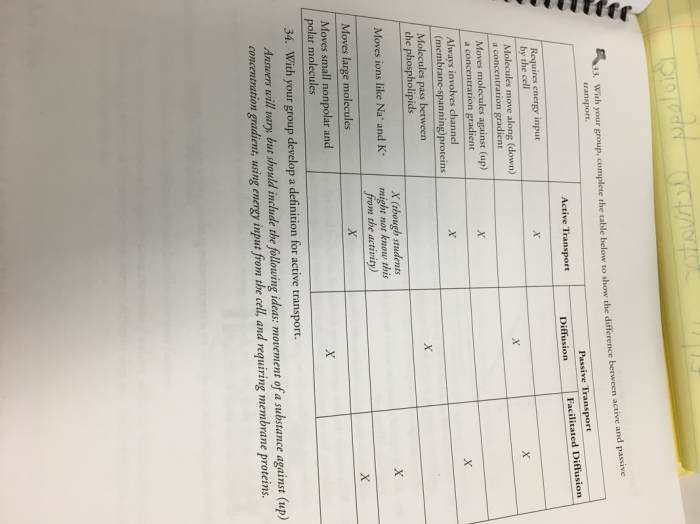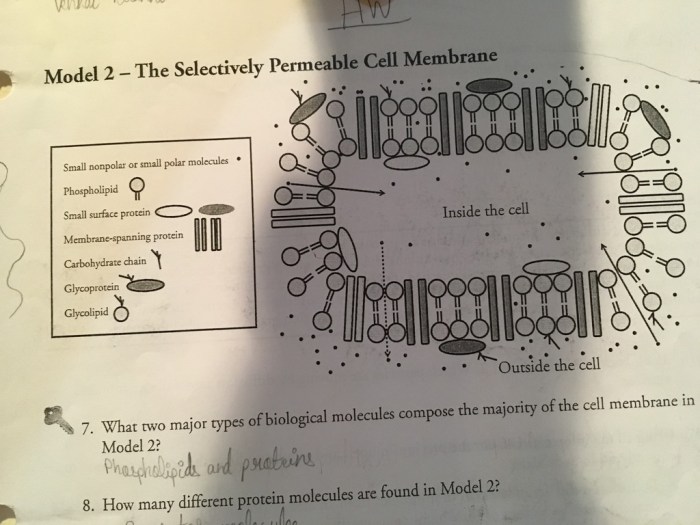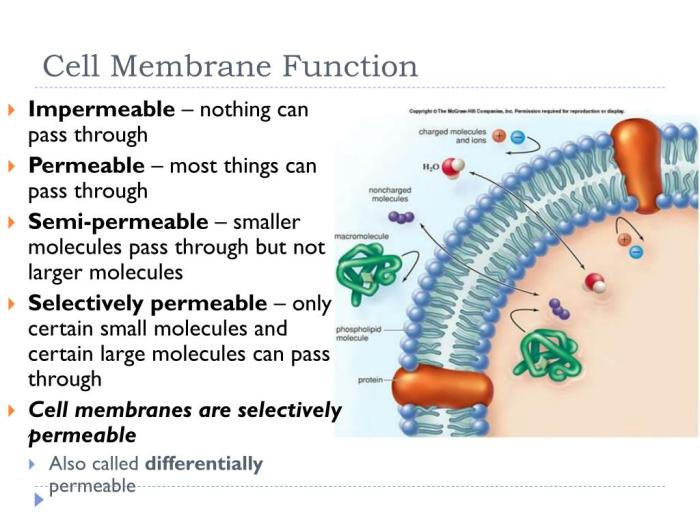The membrane structure and function pogil is a fundamental concept in cell biology that explores the intricate architecture and diverse roles of the cell membrane. This selectively permeable barrier not only defines the boundaries of the cell but also plays a crucial role in regulating the movement of molecules, maintaining cellular homeostasis, and facilitating cell signaling.
As we delve into the fascinating world of membrane biology, we will unravel the secrets of its structure, function, dynamics, and pathologies, providing a comprehensive understanding of this essential cellular component.
From its basic lipid bilayer composition to the specialized proteins embedded within, the cell membrane is a marvel of biological engineering. Its dynamic nature allows it to adapt to changing cellular conditions, while its role in disease pathogenesis highlights the critical importance of membrane integrity for overall health.
Membrane Structure

The cell membrane, also known as the plasma membrane, is a thin, flexible barrier that surrounds the cell and regulates the movement of molecules into and out of the cell. It is composed of a phospholipid bilayer, a double layer of phospholipids that are arranged with their hydrophilic heads facing outward and their hydrophobic tails facing inward.
The phospholipid bilayer is impermeable to most molecules, which helps to maintain the cell’s internal environment and protect it from harmful substances.
Lipids
The lipids that make up the cell membrane are primarily phospholipids, glycolipids, and cholesterol. Phospholipids are the most abundant type of lipid in the cell membrane. They are composed of a glycerol molecule, two fatty acid chains, and a phosphate group.
The fatty acid chains are typically saturated, which means that they are fully hydrogenated. Glycolipids are similar to phospholipids, but they have a carbohydrate group attached to the phosphate group. Cholesterol is a steroid that helps to stabilize the cell membrane and prevent it from becoming too fluid.
Proteins
Proteins are also an important component of the cell membrane. They are responsible for a variety of functions, including transporting molecules across the membrane, signaling, and cell adhesion. Membrane proteins can be either integral proteins or peripheral proteins. Integral proteins are embedded in the phospholipid bilayer, while peripheral proteins are attached to the surface of the membrane.
Membrane Function

The cell membrane regulates the movement of molecules across the cell. It does this by controlling the permeability of the membrane to different molecules. The permeability of the membrane is determined by the composition of the membrane and the presence of membrane proteins.
Membrane Transport Proteins, Membrane structure and function pogil
Membrane transport proteins are proteins that help to move molecules across the cell membrane. There are two main types of membrane transport proteins: channels and carriers. Channels are pores that allow molecules to pass through the membrane without the need for energy.
Carriers are proteins that bind to molecules and then transport them across the membrane. Carriers require energy to transport molecules across the membrane.
Cell Signaling
The cell membrane also plays a role in cell signaling. Cell signaling is the process by which cells communicate with each other. Cells can send signals to each other by releasing chemical messengers into the extracellular environment. These chemical messengers can bind to receptors on the surface of the cell membrane, which then triggers a response inside the cell.
Membrane Dynamics
The cell membrane is a dynamic structure that is constantly changing. It is able to maintain its fluidity by the movement of lipids and proteins within the membrane. The fluidity of the membrane is important for a variety of cell functions, including cell growth, cell division, and cell signaling.
Membrane Fluidity
The fluidity of the cell membrane is determined by the composition of the membrane and the temperature. The presence of unsaturated fatty acids in the membrane increases the fluidity of the membrane, while the presence of cholesterol decreases the fluidity of the membrane.
The temperature also affects the fluidity of the membrane. The higher the temperature, the more fluid the membrane.
Role of Membrane Fluidity
The fluidity of the cell membrane is important for a variety of cell functions. For example, the fluidity of the membrane allows cells to grow and divide. It also allows cells to signal to each other and to respond to changes in the environment.
Membrane Pathologies: Membrane Structure And Function Pogil

Membrane defects can lead to a variety of diseases. These diseases can be caused by mutations in genes that encode membrane proteins or by the presence of toxins that damage the membrane. Membrane defects can also be caused by aging.
Membrane Diseases
There are a number of diseases that are caused by membrane defects. These diseases include cystic fibrosis, sickle cell anemia, and Alzheimer’s disease. Cystic fibrosis is a genetic disease that is caused by a mutation in the gene that encodes the cystic fibrosis transmembrane conductance regulator (CFTR) protein.
The CFTR protein is a chloride channel that is responsible for the transport of chloride ions across the cell membrane. Mutations in the CFTR gene can lead to a decrease in the number of CFTR proteins in the cell membrane, which can result in a buildup of chloride ions in the cells.
This buildup of chloride ions can lead to the formation of mucus plugs in the airways, which can block the airways and make it difficult to breathe. Sickle cell anemia is a genetic disease that is caused by a mutation in the gene that encodes the beta-globin protein.
The beta-globin protein is a component of hemoglobin, which is the protein that carries oxygen in the blood. Mutations in the beta-globin gene can lead to the production of abnormal hemoglobin molecules, which can cause red blood cells to become sickle-shaped.
Sickle-shaped red blood cells are less flexible than normal red blood cells, which can lead to blockages in the blood vessels and can cause pain, tissue damage, and organ failure. Alzheimer’s disease is a neurodegenerative disease that is characterized by the accumulation of amyloid plaques in the brain.
Amyloid plaques are composed of a protein called amyloid-beta. Amyloid-beta is produced by the cleavage of a larger protein called amyloid precursor protein (APP). Mutations in the APP gene can lead to an increase in the production of amyloid-beta, which can result in the formation of amyloid plaques.
Amyloid plaques can damage neurons and lead to the development of Alzheimer’s disease.
Membrane Repair
The cell membrane is constantly being damaged by a variety of factors, including mechanical stress, oxidative stress, and toxins. The cell has a number of mechanisms to repair damaged membranes. These mechanisms include the fusion of vesicles with the damaged membrane, the patching of the damaged membrane with proteins, and the removal of damaged membrane fragments.
Membrane repair is essential for maintaining the integrity of the cell and for protecting the cell from harmful substances.
Popular Questions
What is the basic structure of a cell membrane?
The cell membrane is a phospholipid bilayer, composed of two layers of phospholipids with their hydrophilic heads facing outward and their hydrophobic tails facing inward.
What are the different types of lipids that make up the membrane?
The membrane is composed of a variety of lipids, including phospholipids, cholesterol, and glycolipids.
What is the role of proteins in membrane structure and function?
Proteins are embedded in the membrane and play a variety of roles, including transport, signaling, and adhesion.
How does the membrane regulate the movement of molecules across the cell?
The membrane regulates the movement of molecules across the cell through a variety of mechanisms, including passive diffusion, facilitated diffusion, and active transport.
What is the role of the membrane in cell signaling?
The membrane plays a role in cell signaling by transmitting signals from the outside of the cell to the inside.
